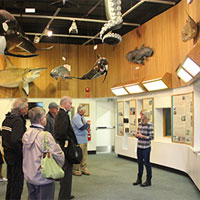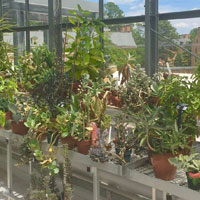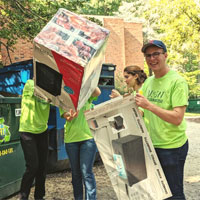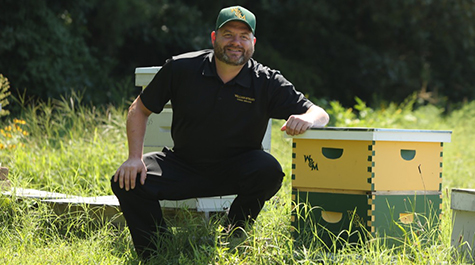W&M announces 2020 spring Green Fee projects
The William & Mary Committee on Sustainability has announced the spring 2020 Green Fee awards. This semester, seven campus projects were awarded a total of $40,180 in grants.
Since its establishment in 2008, the W&M Green Fee program has funded more than $1.6 million worth of sustainability-related projects. The Green Fee advances the W&M Committee on Sustainability’s tripartite goals of teaching, research and public service. The committee accepts Green Fee proposals every semester.
Throughout the 2019-2020 academic year, stakeholders from across campus collaborated on work toward a university Climate Action Plan. As a part of this plan, W&M Sustainability announced a partnership and joint-carbon neutrality goal for 2030 with the University of Virginia. The Climate Action Plan is still under construction, with a tentative fall 2020 rollout date.
This spring’s Green Fee projects are:
Educational Exhibit for the VIMS Visitors Center
$5,625 to Sally Brooks, Assistant Director of Advancement — Outreach and Engagement, and Dan Sennett, Marine Aquaculture Specialist
 To promote the importance of freshwater habitats to the Chesapeake Bay watershed, the committee will assist in funding the creation of a living exhibit in the Virginia Institute of Marine Science Visitors Center. This project will create a replica freshwater habitat within an existing aquarium tank.
To promote the importance of freshwater habitats to the Chesapeake Bay watershed, the committee will assist in funding the creation of a living exhibit in the Virginia Institute of Marine Science Visitors Center. This project will create a replica freshwater habitat within an existing aquarium tank.
The addition of this exhibit will allow the Visitors Center to expand on its displays of habitat types within the watershed. It will provide an excellent opportunity to educate visitors about the diversity of plants and animals found throughout the watershed and the importance of water conservation and water quality.
Events2HVAC Phase II
$20,030 to Jeremy Condron, Lead Building Automation System Specialist at Facilities Management Building Automation Department
Building upon the success of Events2HVAC Phase I, the Building Automation Department will continue to reduce the amount of energy consumption, extend the life of the mechanical equipment and reduce W&M’s labor cost by incorporating selected buildings into the Events2HVAC system.
Events2HVAC integrates the Event Management System and the Building Automation System controls together, which gives the ability to reduce the need for conditioned space when spaces are not in service or scheduled. This already has been established at the Raymond A. Mason School of Business and has reduced its hours in spaces by more than 30%. This reduction of energy is shown not only at the building’s electrical and mechanical level, but in the central plant’s production of heating and cooling water for distribution. The team is proud of their accomplishments so far and will continue to aid in the reduction of the campus community’s carbon footprint.
Surveying Property Owners for Resilient Communities
$5,145 to Amanda Guthrie, Virginia Institute of Marine Science Ph.D. candidate, and Advisor Donna Bilkovic, Research Associate Professor
Coastal communities are highly vulnerable to sea-level rise and increased coastal erosion. Property owners can modify their shoreline to reduce shoreline erosion by installing shoreline armoring (bulkheads, riprap) or living shorelines (planted marshes). In contrast to armoring, living shorelines mitigate erosion, provide other coastal benefits and can adapt to rising sea levels.
Green Fee grant recipients will survey property owners to understand what factors they consider when deciding how to modify their shoreline. Our survey results will allow us to develop more targeted outreach programs and initiatives hosted through the Center for Coastal Resources Management at VIMS. Furthermore, Amanda will use the work as a case study in an upcoming undergraduate seminar course.
Anonymous Pharmaceutical Disposal Receptacle
$2,050 to Maj. Don Butler, William & Mary Police Department
Funds will be used to purchase a permanently mounted anonymous pharmaceutical disposal receptacle. This will allow for the safe, convenient and anonymous disposal of unwanted, unneeded and expired prescription drugs.
Its usage will help prevent drug abuse, as well as protect rivers, lakes, other water sources and grounds from medicinal waste. In doing so, humans, fish and wildlife also will be protected from chemicals and contaminates. Protecting the ecosystem in this manner enhances sustainability.
Observation Bee Hives
$400 to Ella Kasten ’20 and Katie Fosnight ’22, and Advisor Stephen Moyer, Operations Manager for the Sadler Center, Dining Services
The purchase of observation hives allows for parts of the W&M Apiary, which is located at KelRae Farm, to be brought to campus in order to educate the student body on honeybees, bee keeping and the importance of pollinators in local food systems.
Observation hives will be brought in to give students an inside look at what goes on in beehives in conjunction with short educational talks. Students will be given packets of native seeds to plant so they can do their part to sustain bee populations in the Williamsburg area.
Greenhouse Compost for Waste Reduction
$430 to Patty White Jackson, Greenhouse Manager, and Grace Dho ’23
 The greenhouse team is going to install a compost bin system on the south side of the Integrated Science Center to reduce the amount of waste the greenhouse produces. A compost system near the ISC will allow a productive and environmentally friendly way to discard a majority of the greenhouse’s waste.
The greenhouse team is going to install a compost bin system on the south side of the Integrated Science Center to reduce the amount of waste the greenhouse produces. A compost system near the ISC will allow a productive and environmentally friendly way to discard a majority of the greenhouse’s waste.
The greenhouse will no longer be using plastic bags for throwing away natural waste, and it will instead be recreating the waste into usable soil. The bin system will serve to educate the public about composting, and the soil resulting from the compost will be distributed during Earth Week.
EcoReps Peer Education Program
$1,000 to Jenny Fam, M.Ed. ’20, and Advisor Calandra Waters Lake, Director of Sustainability
 The EcoReps are knowledgeable volunteers trained on a variety of sustainability topics. The awarded funds will allow the EcoReps to receive more robust training sessions — for example, field trips to recycling/composting sites for firsthand experience.
The EcoReps are knowledgeable volunteers trained on a variety of sustainability topics. The awarded funds will allow the EcoReps to receive more robust training sessions — for example, field trips to recycling/composting sites for firsthand experience.
A more holistic training allows the EcoReps to be better equipped for outreach programs, raising sustainability awareness in the wider community on and off campus. This peer education program promotes volunteerism and sustainability by fostering a welcoming environment for students to learn and apply knowledge learned.
Longhorned Milkweed Beetles & Common Milkweed
$5,500 to Margaret Donnan ’22 and Advisor Harmony Dalgleish, Assistant Professor of Biology
Common milkweed is home to a variety of insects, including monarch butterflies as caterpillars. Much more is known about the monarch than about one of common milkweed’s other residents — the longhorned milkweed beetle.
The beetles affect multiple parts of the plant throughout its life cycle, suggesting that the beetle could have a greater effect on milkweed than the monarch does. This research project will explore that effect and whether it contributes to milkweed’s growth and/or declining population. Signs will be placed outside of a research bay in the W&M Greenhouse to educate the W&M community and other greenhouse visitors about this research and its connections to conservation efforts.
 Skip to main content
Skip to main content

